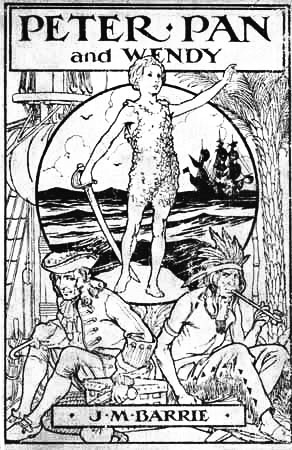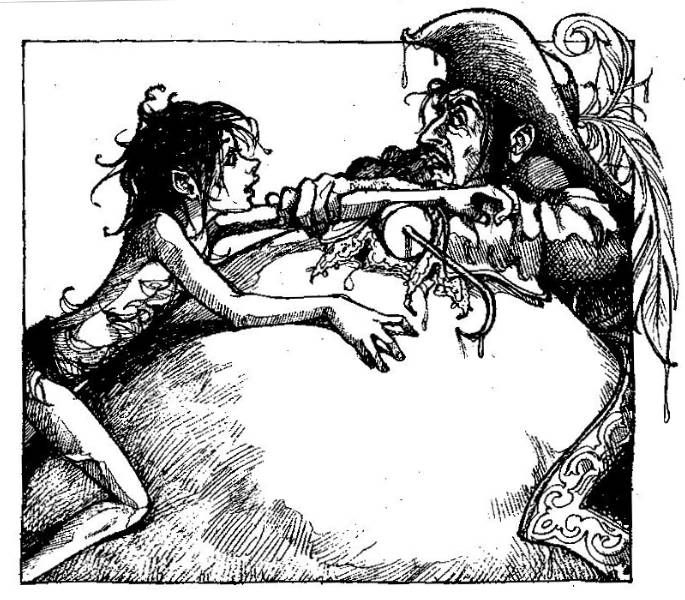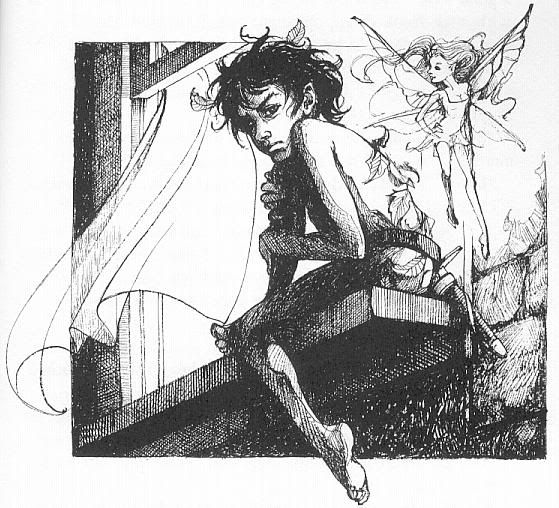“The moment you doubt whether you can fly, you cease for ever to be able to do it.”
---J.M. Barrie, Peter Pan
 | |
| 1915 Edition of Peter & Wendy by F.D. Bedford |
The turn of the century in America brought forth such valuable classics as
The Wizard of Oz. To the East
Peter Pan arrived in London, England, developed by the imagination of
Sir J. M. Barrie, Author and Playwright.
Peter Pan is an unusual hero who sets a standard for fantasy characters. He is sealed to his fairy companions through his magical ability to remain a child. His capacity to relate to the fairy realm stems from his inability to relate to adult rationality.
Peter Pan was the first to suggest that perhaps you lose something when you 'Grow Up', the irony of his existence appears on the first page as the first words of Mr. Barrie's 1911 novel, "All children, except one, grow up" In this simple statement/sentiment a tragic hero is born. Peter can easily relate to the fairies because he has not lost the ability to believe in them but on the other-side he is unable to understand the motivations and language of adults.
 |
| Trina Schart Hyman 1980 |
Captain Hook represents the adults, who are pirates of sorts, eager to claim and destroy in the name of power and constantly running from their fear of death, the old clock swallowed by the
Giant Crocodile. It is fascinating to look even deeper into the political elements of this intricate tale. There are two types of adult that reside in
Neverland, the
Pirates and the
Indians. The destructive pirates represent the evil that moves across the land with no remorse for their destructive nature. The Indians are equally dangerous but certainly an ally to young Peter. They have no desire to conquer and therefore are closer to understanding and communicating with land and its many peculiar inhabitants. Here Peter is given the opportunity to view two methods of lifestyle and draws closer to the Indians. Perhaps the Indians are safe because they are tied innocence.
 |
| Trina Schart Hyman, 1980 |
Peter Pan has survived the test of time. He beckons us to remember our imagination by reminding us that our failure to believe carries a destructive force.
.JPG/640px-Peter_Pan_statue_in_Kensington_Gardens_in_the_City_of_Westminster_in_London,_spring_2013_(12).JPG) |
| Kensington Gardens, London, England (Wikipedia) |
A statue of Peter resides in Kensington Gardens, London, England, the very park in which Peter was conceived by Sir J. M. Barrie. Peter's first appearance in literature was in a book titled:
The Little White Bird published in 1902. In this novel for adults Peter appears in a few chapters where he is cared for by the fairies in Kensington Gardens, estranged from his original family. Later in
Peter and Wendy a conclusion is drawn out that Peter was cared for by the fairies till he reached an age when he was whisked away to Neverland. You never grow old in Neverland. Perhaps the fairies knew a particular age before adulthood that Peter could be most relate-able and there he remains, a fairy in his own right.



.JPG/640px-Peter_Pan_statue_in_Kensington_Gardens_in_the_City_of_Westminster_in_London,_spring_2013_(12).JPG)
Perhaps it would behoove us all to keep in close touch to the child within <3
ReplyDeletePeter truly is the child within all of us. Some day I may figure out what I will do when I grow up.
ReplyDelete